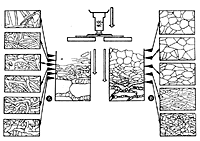Mantle preparations should be done according to the descriptions published by Agerer (1991): Methods in Microbiology 23: 25-73. A Normarski interference contrast microscope (DIC) is most convenient to examine the mantles, since it allows to focus different mantle layers consecutively, without interference from hyphal layers laying beneath or above the focused level (A). One part of the mantle pieces should be oriented with the outer side up, another part with the inner side up. Only very dark mantles, or mantles covered by a lot of strongly light reflecting crystals or soil particles need to be sectioned; these sections can be made as thick tangential sections (it is enough to halve the mantle) with the aid of a cryotome. It is necessary to always apply the highest magnification (1000×); only for discerning patterns of hyphal arrangement, lower magnifications should be used (400×). The application of a well adjusted microscope is self-evident.
Middle mantle layers are generally those portions of the mantle which lay between the outer mantle layers (surface) and the inner mantle layers (surface). Most of the time there are intergradations between the structures of outer and inner mantle layers. Sometimes, however, distinct differences in structure occur. In case of intergradations, the topographical midth should be considered for the characterizations.
 A |